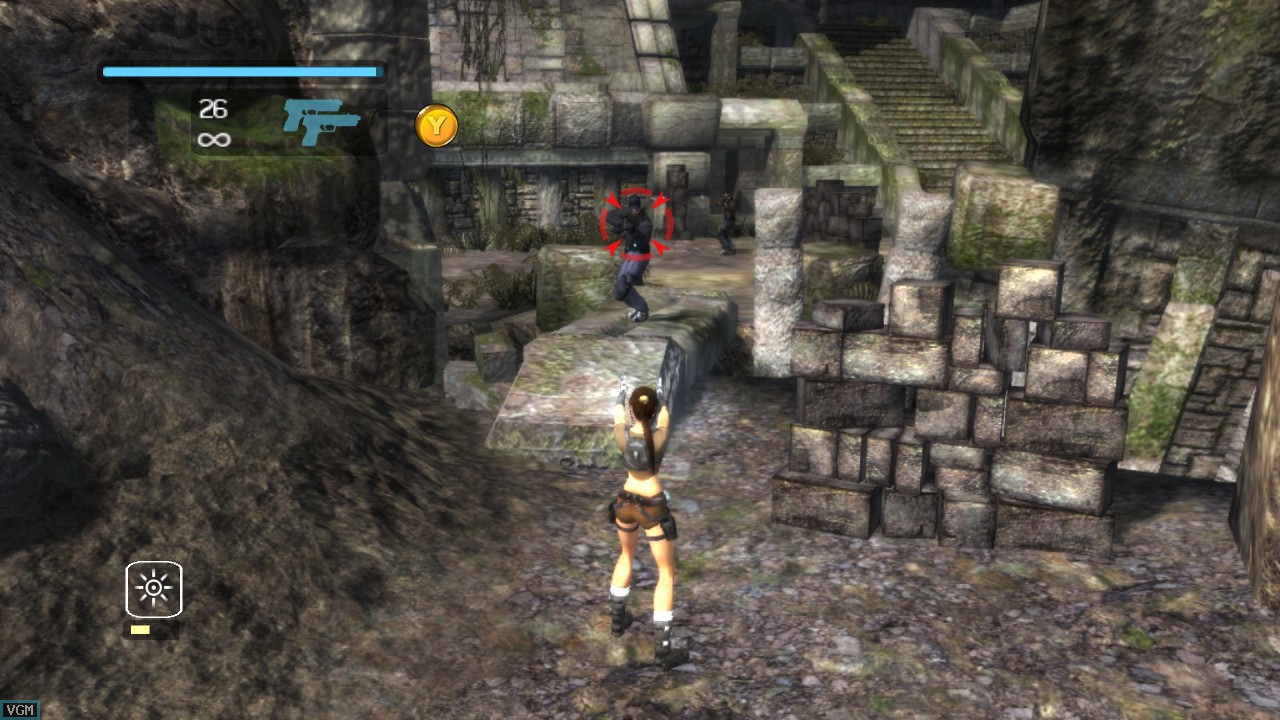
If you’re a Lara Croft fan, there’s been precious little to cheer about since she burst on to the gaming scene back in 1996. As each new game in the series was released, the quality progressively got worse. By the time her last foray onto the consoles, Tomb Raider: Angel of Darkness, was released, it looked as if she might be forced into retirement by sheer mishandling. Thankfully, EIDOS Interactive, took the creative reins away from CORE Design and handed them to Crystal Dynamics. As a result, Tomb Raider: Legend returns the busty Ms. Croft to glory.
The problem with the most recent Tomb Raider games is that there wasn’t much actual tomb raiding going on. Somehow, Lara Croft had become an ersatz Solid Snake. Add some frustratingly horrid control and the seemingly ever-present wonky camera and playing a Tomb Raider game had become more of an exercise in masochism than entertainment. Tomb Raider: Legend addresses these problems directly. The game returns Lara to more exotic locales, with some fantastic environment graphics. (The water effects are, for the most part, the most realistic-looking I’ve ever seen in a game.) The tiresome crate puzzles of past games have been refined into well-constructed brain-teasers that require a nice balance of thought and dexterity to solve.
The game’s plot won’t win any awards for originality, but at least it does get back to Lara’s roots in terms of letting the archaeologist/adventurer do things that you’d expect an Indiana Jones-type hero to do. To complete her quest, Lara will have to swing on vines, climb sheer walls, duke it out with armed thugs and use her noggin to solve those aforementioned puzzles. Occasionally, Lara will have to ride a motorcycle to get from one end of a level to the other. The vehicle-based sections of the game are probably the weakest part of the whole package because they’re not particularly challenging and they seem to exist only to pad the length of the game. I finished Tomb Raider: Legend in about seven hours, so it’s not a long game to begin with.
The best part of Tomb Raider: Legend is the control, which has been greatly improved since the last entry into the series. Rather than using an odd combination of the d-pad and analog sticks to control Lara’s speed and direction, the game uses the left analog stick by itself to move Lara and the right stick to control the game’s camera. The d-pad is used to select weapons, turn Lara’s flashlight on and off and to peer through Lara’s binoculars. The binoculars are a key element in solving the game’s puzzles as they can tell you what and how parts of a level can be manipulated. For example, if you point them at a statue, an indicator will let you know whether the statue can be moved or if it can be broken. Sizing up the elements in a puzzle lets you concentrate on solving it rather than hunting around trying to find the pieces. Even without the binoculars, the game does a nice job in letting you solve the puzzles on your own without too much hand-holding.
Lara’s look has changed a little bit as well. She now looks (and sounds) more like the Lara Croft portrayed in the movies by Angelina Jolie. She still retains her trademark bosom, but her face has been altered to be more expressive. Her wardrobe has been enhanced too. The game’s Tokyo, Japan level — one of the few that doesn’t take place in the wilderness — features Lara in a black dress that will probably get a rise out of more than a few male gamers (and, I’m sure, a few female gamers too).
Alas, Tomb Raider: Legend is not perfect. The targeting selector will occasionally target the wrong items at the worst possible time. This is sorely evident in one of the game’s later boss battles and provided one of the few times I actually got mad at the game for seeming cheap. The level design is also somewhat inconsistent. The game’s early levels are laid out in such a way that they seem natural. The game’s final levels occasionally left me lost in terms of where to go or what to do next. And, it wouldn’t be a Tomb Raider game unless there were some camera issues but they’re nowhere near as bad as in past entries. These are all minor problems compared to what Tomb Raider fans have dealt with in the past.
Tomb Raider: Legend is the best game of its type since Legacy of Kain: Soul Reaver, which was also designed by Crystal Dynamics. It’s good to see Lara return to form. The game’s ending leads us to believe a sequel is forthcoming. For the first time in a long while, anticipating a new Tomb Raider game doesn’t sound like a bad idea.
8 out of 10.

